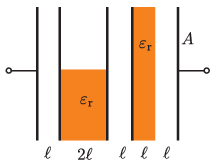 Problem P. 5424. (September 2022)
Problem P. 5424. (September 2022)
P. 5424. The capacitor system shown in the figure is made of 5 square-shaped uncharged metal plates of area \(\displaystyle A\). The distance between the plates is \(\displaystyle \ell\) or \(\displaystyle 2\ell\), and the edge effects are negligible because \(\displaystyle \ell^2\ll A\).

Between the plates, in the white regions there is air and in the brown regions there is some insulating material of relative dielectric constant \(\displaystyle \varepsilon_{\mathrm{r}}\). In both condensers which contain dielectric, the dielectric material fills half of the area between the plates of the condensers.
What is the equivalent capacitance of the arrangement?
(5 pont)
Deadline expired on October 17, 2022.
Sorry, the solution is available only in Hungarian. Google translation
Megoldás. Jelöljük az \(\displaystyle A\) területű, \(\displaystyle \ell\) lemeztávolságú, levegőben (gyakorlatilag vákuumban) elhelyezkedő síkkondenzátor \(\displaystyle \varepsilon_0 A/\ell\) kapacitását \(\displaystyle C_0\)-lal.
Az 5 fémlemez által határolt 4 térrész 4 darab sorosan kapcsolt kondenzátornak tekinthető. Ezek közül a balról az első és a harmadik kondenzátor kapacitása ugyanakkora:
\(\displaystyle C_1=C_3=C_0. \)
A második egység két párhuzamosan kapcsolt kondenzátornak, a negyedik pedig két sorosan kapcsolt kondenzátornak tekinthető. Mivel a kapacitás a lemezek területével és a relatív dielektromos állandóval egyenesen, a lemezek távolságával pedig fordítottan arányos, ezt kapjuk:
\(\displaystyle C_2=\frac{1}{4}\left(1+\varepsilon_{\rm r}\right)C_0,\)
továbbá
\(\displaystyle C_4=\left(1+\frac{1}{\varepsilon_{\rm r}}\right)^{-1}C_0=\frac{\varepsilon_{\rm r}}{1+\varepsilon_{\rm r}}C_0.\)
Az eredő kapacitás ezek szerint
\(\displaystyle C_\text{eredő}=\left(\frac{1}{C_1} +\frac{1}{C_2}+\frac{1}{C_3}+\frac{1}{C_4}\right)^{-1}C_0= \frac{\varepsilon_{\rm r}(1+\varepsilon_{\rm r})}{3\varepsilon^2_{\rm r}+8\varepsilon_{\rm r}+1}\,\frac{\varepsilon_0A}{\ell}.\)
Statistics:
26 students sent a solution. 5 points: Arnold Lőrinc, Bencz Benedek, Chrobák Gergő, Fazekas Marcell, Hüvös Gergely, Kondor Botond Dávid, Lévai Dominik Márk, Lincoln Liu, Molnár Kristóf, Ruzsa Bence Márk, Schmercz Blanka, Seprődi Barnabás Bendegúz, Vágó Botond, Vári Gergely Péter. 4 points: Kismárton Gábor, Nemeskéri Dániel. 3 points: 4 students. 2 points: 2 students. 1 point: 1 student.
Problems in Physics of KöMaL, September 2022
